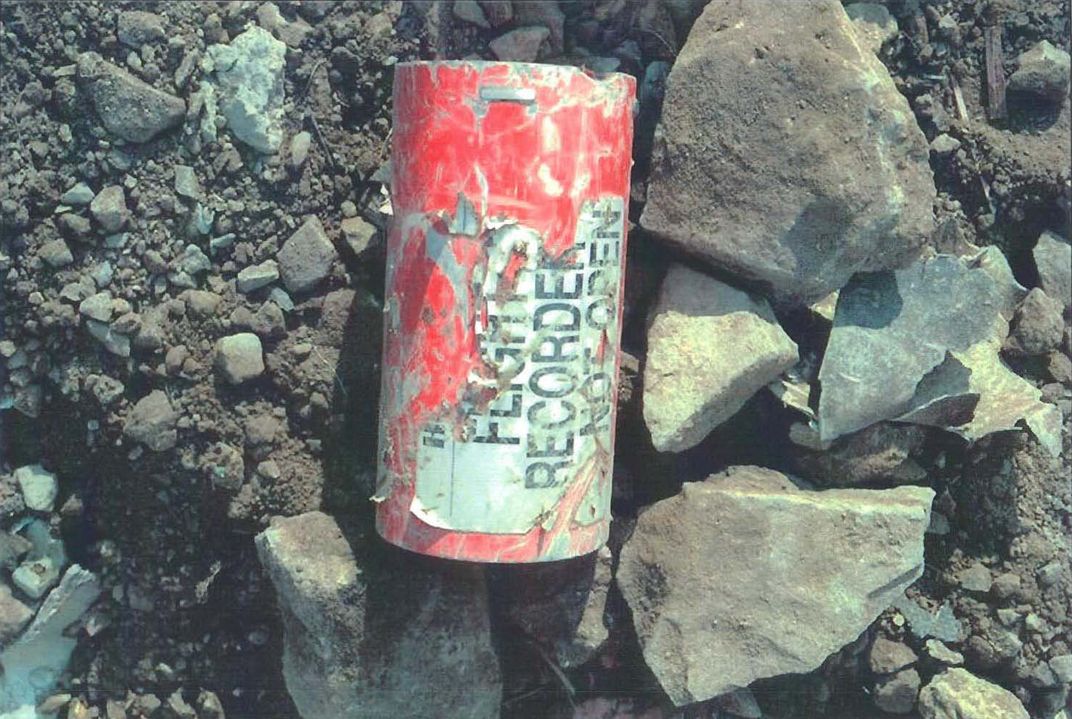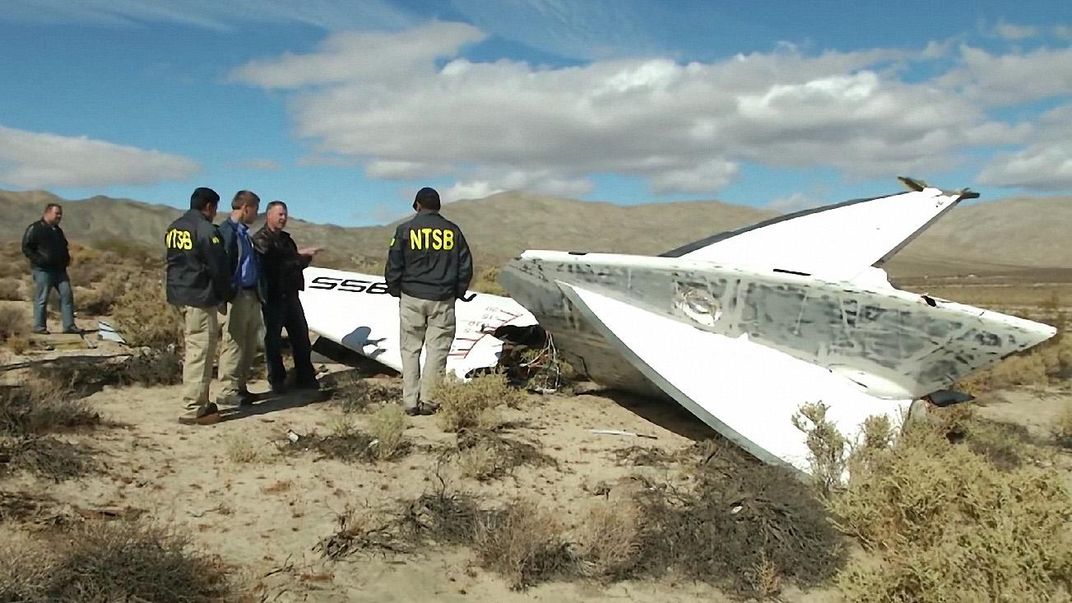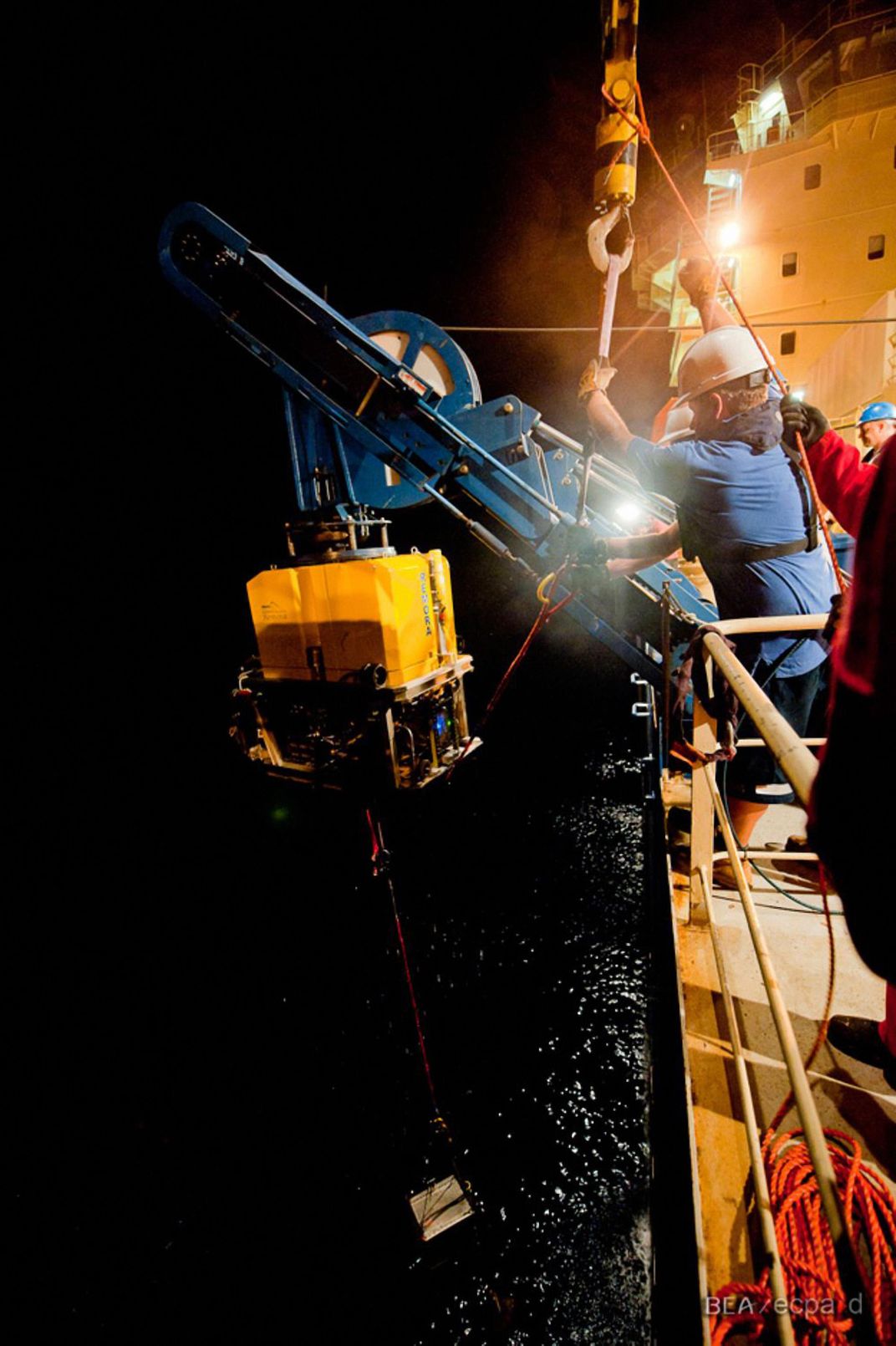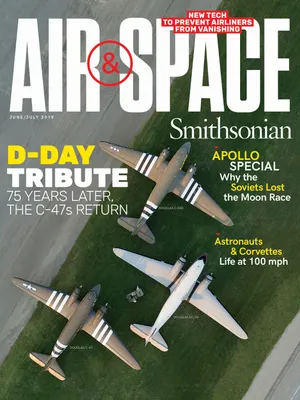Thinking Outside the Black Box
New technologies may offer alternatives to today’s flight recorders.
/https://tf-cmsv2-smithsonianmag-media.s3.amazonaws.com/filer/26/8d/268db9f6-bf3e-4f67-90d8-2fb0fcccbc19/14c_jj2019_malaysianairlinessearch5c_live.jpg)

It has been a difficult decade for airline travel and those who investigate accidents.
June 2009 saw the disappearance of Air France Flight 447, with 228 passengers and crew, somewhere over the Atlantic Ocean. After a month of futile deep-ocean searches, the batteries on the flight data recorders’ underwater locator beacons were assumed to be dead and the search was called off. Nearly two years later, the black boxes turned up after extensive mapping of potential flight paths.
Investigators from multiple countries are still shaking their heads over what transpired in the case of EgyptAir Flight 804, which plunged into the Mediterranean Sea in May 2016 with 66 people on board. The Airbus A320’s flight data recorders were recovered less than a month later, but the data proved to be inconclusive. With no clear explanation offered of what happened, theories swung from terrorism to an electrical fire in the avionics compartment to the pilot’s iPhone overheating. Many agreed that if the airplane had been equipped with a cockpit video recorder, investigators would have had a far easier time determining the cause of the tragedy.
And then there’s Malaysia Airlines Flight 370, whose disappearance over the Indian Ocean in March 2014 has turned into one of the world’s greatest airline disaster mysteries (see “What Went Wrong on Malaysia Airlines Flight 370?” September 2016). Investigators called off the $160 million search in January 2017, but some are still debating whether search teams had been looking in an entirely wrong area of the ocean.
Most recently, investigators were confronted with the mystery of two Boeing 737s that crashed less than five months apart in Indonesia and Ethiopia. Initially, the Federal Aviation Administration decided not to ground the Boeing 737 MAX in the United States, citing lack of information from the Ethiopian airliner’s flight data recorders. (Despite requests from Boeing, Ethiopian authorities did not release the FDRs to U.S. investigators, choosing instead to send the recorders to France several days later.) But the FAA reversed its decision when it obtained data from Aireon—a company that operates receivers on a newly completed constellation of Iridium satellites—which revealed part of what the FDRs later showed: that the final seconds of the Ethiopian airliner’s flight were chillingly similar to those of the Indonesian airplane. (See “Iridium Satellites Launch a New Era of Global Tracking.”)
These events have stirred debate, once again, about the usefulness of flight recorders that are physically tethered to an airplane. At a time when it is possible to locate a lost cellphone from halfway around the world, the idea of flight recorders whose data can’t be accessed remotely (but must be downloaded from the box itself) seems as outdated as complimentary meals on cross-country flights. The Aireon receivers on Iridium NEXT satellites, for instance, collect data transmitted by an airplane’s transponder to track position, speed, and altitude at intervals of less than eight seconds. Is it time the august black box, an instrument that has been in use since the 1950s, be retired and replaced by something else?
* * *
In a hallway on the fifth floor of the National Transportation Safety Board (NTSB) headquarters in Washington, D.C., an interesting display tracks the sluggish evolution of the black box. A 20-foot-long glass case holds a mini-museum of flight data recorders and cockpit voice recorders dating back to the Eisenhower era. Some are mangled pieces of equipment, showing the scars of gruesome accidents. Others look brand new.
There’s an original 1950s flight recorder, which used a stylus to etch basic flight conditions—such as altitude, airspeed, heading, vertical acceleration, and time—onto a foil magazine that could be used only once. Investigators had to use a microscope to decipher the little squiggles and lines, which looked something like an EKG reading. Data and flight recorders from the 1960s employed magnetic tape to store flight information, a technological achievement that was still in use as recently as the early 1990s, when solid-state recorders became the norm.
As is by now well known, the black box is not black. All of these devices are painted a bright orange to help with visibility. Theories abound regarding the origin of the term “black box,” including rumors that the mysterious contents could be safely accessed only in a dark room or that the device turns black when it gets charred. The truth is much more mundane. In the post-World War II field of electronic circuitry, black box became the ubiquitous term for a self-contained electronic device whose input and output were more defining than its internal operations. But, since the mid-1960s, the media has used the avionics term almost exclusively to describe flight recorders, no doubt because of the sense of mystery it conveys in the aftermath of an air disaster.
Unlike the comparatively crude designs on display at the NTSB, today’s FDRs can record thousands of parameters, far more than just the 88 mandated by the Federal Aviation Administration. Some recorders archive voice and data in one unit, saving precious space. Most are mounted in the tail section of an airplane, which is typically the last part to make impact and is therefore most likely to survive a crash.
Since a well-maintained airliner can fly for decades, many aircraft around the world—particularly those from poorer countries—are still equipped with some of the antiquated devices in the NTSB gallery. In fact, specialists in the agency’s recorders laboratory must sometimes use similar versions to help download recorders sent in from around the world. (About 25 to 30 percent of the black boxes the NTSB receives come from foreign countries without a similar agency.) If a flight or voice recorder is too damaged to use, engineers remove its memory module and insert it into a surrogate recorder in order to download the data. There’s a rack in the lab holding approximately 20 of these recorders from different manufacturers and different eras. “We keep everything because we never know when something 40 years old is going to come through the door and we need to resurrect something,” says Sarah McComb, who heads the agency’s vehicle recorder division.
McComb says the NTSB receives on average 550 to 600 devices a year, and that number includes data and cockpit recorders as well as GPS units, iPhones, and tablets—reflecting the growing popularity of aviation apps, such as ForeFlight Mobile and Garmin Pilot, which have digital logbooks and provide tools for flight planning and navigation. The prevalence of private pilots recording their own flights has provided investigators new tools in deciphering the causes of general aviation crashes, but also new challenges. The agency has devoted an entire room to extracting data from these devices, which, unlike black boxes, are not designed to survive accidents. Recorder specialists must rely on all sorts of high-tech tools—high-powered microscopes, X-ray machines, and the like—to survey and repair tiny damaged memory chips. “All this,” says McComb surveying the space, “never even existed 10 years ago.”
Many general aviation investigations involve analyzing video captured from a pilot’s GoPro or smartphone. And while the use of video recording devices has become commonplace among private pilots, you won’t find a camera mounted in the cockpit on your next commercial flight.
Cockpit video recorders are something the NTSB has been recommending since 2000, but the FAA has repeatedly demurred. As recently as 2016, the FAA concluded that “we have not seen any new compelling evidence to require installation of cockpit image recorders.” But it’s something McComb thinks would greatly aid investigators. “Now that you have all these glass cockpits and modern systems, it’s valuable to know not just how the systems are working but how the crew is interacting with them,” she says. “For instance, if a pilot goes into a different screen or system, it’s helpful to know what screen they were looking at when something happened. The more complex the systems, the more information we need to understand how things are working.”
Video played a critical role in the investigation of Virgin Galactic’s SpaceShipTwo in 2014, when it broke apart over California’s Mojave Desert. On its test flight, cockpit-mounted cameras recorded—in real time—the actions of the copilot as he prematurely deployed the ship’s “feathering” mechanism, which rotates the back sections of the wings and is used to aid in reentry.
“If we didn’t have video and just had data from the crash, we would have painstakingly looked at every part for a structural flaw, a crack, a fatigue, and not found anything,” says John DeLisi, director of the NTSB’s Office of Aviation Safety. “We would have talked through all the systems’ protocols, but the pilot didn’t say anything on the radio about throwing the handle. Any pilot would have said, ‘No, he wouldn’t have done it.’ But he did it, and it was the video that gave such clarity and focus.”


In a world where video cameras record our every transaction, from the bank to the drive-through window at McDonald’s, it might seem only logical to equip commercial airliners with video recorders. But convincing pilots, pilots’ unions, and the airlines has been a tough sell. Carriers bring up issues of cost to install the equipment, and pilots see it as an invasion of privacy. Or as Steve Abdu, a commercial airline pilot for the last 42 years bluntly puts it: “How would you like to have a camera looking over your shoulder at work?”
Pilots worry that footage could be leaked to the public, with the final moments of their lives playing out as an endless stream of viral videos—an agonizing prospect for the pilots’ families. Such footage, they say, also could be used to unfairly assign blame to the flight crew, especially if the incident ever found its way into court, where a jury would lack the expertise to accurately assess what they were viewing.
Doug Moss, who flies 757s for a major U.S. carrier and teaches a course on human factors in aviation at the University of Southern California, says that, unlike reading the data from flight recorders, which is objective information, deciphering video images can often be a subjective art. “With video, you have to interpret what you’re looking at, and what you see can be misleading,” he says. “You might see a pilot pushing on a rudder pedal, but it could be the rudder pedal pushing back on the pilot, which you visually can’t determine.”
He also cites studies concerning how being observed in the workplace can alter a person’s behavior—which may or may not be helpful in the cockpit. He describes the scenario in which an exhausted pilot needs to take a quick nap while the airliner is cruising on autopilot at 35,000 feet and his copilot is at the controls. “Maybe the most prudent thing to do is for the guy to take a quick power nap and be ready for the more difficult chores of preparing for landing,” he says. “With a recorder in the cockpit, you can’t do that. It’s a clear violation of the rules and both guys could lose their jobs. But do you want a recorder in there to prevent guys from doing what’s actually safer?”
Instead, Moss thinks chronically cash-strapped airlines should be funneling funds into other technologies. “Right now, the thing that’s missing is ensuring the retrievability of data, and that’s where the money should go—retrievable data streams or ejectable recorders,” says Moss.
Spurred by the MH370 mystery, the International Civil Aviation Organization has recommended that more aircraft be equipped with live streaming and ejectable recorders. The ICAO, the United Nations agency that sets global aviation standards, in March 2016 approved a proposal for all newly designed aircraft to carry tracking devices that can transmit their locations at least once a minute in an emergency. Minute-by-minute reports should provide investigators with a much narrower search area for downed aircraft—just slightly more than 100 square miles. But this and other recommended practices don’t go into effect until 2021 and, even then, they won’t cover the thousands of airplanes currently in the air.
Another technology gained attention in the aftermath of the Malaysia Airlines disaster: a “live black box,” one that could stream data (or voice) in real time to the ground. Technologically, it’s possible, but the concept has been slow to catch on. The expense of outfitting airplanes would be prohibitive, without even considering the associated costs and logistics of overseeing such a large amount of data, from staffing to updating processing and storage systems on the ground.
A less expensive and less data-heavy option might be to wire airplanes to emit so-called “triggered transmissions”—a system by which certain parameters are transmitted only when sensors detect something has gone awry. So if an airliner’s altitude or airspeed suddenly changes, its special transmitter automatically starts sending live data via satellite to the ground.
Several companies currently offer such services, including Calgary-based FLYHT, which has contracted with more than 70, mostly small, airlines and equipment manufacturers worldwide. The company’s Automated Flight Information Reporting System (AFIRS) can be retrofitted to aircraft for an initial outlay of $30,000 to $60,000, depending on its configuration, according to FLYHT CEO Thomas Schmutz. AFIRS is an Iridium-based SATCOM device that transmits data to the ground in real time, where it is then processed and distributed to subscribers through FLYHT’s ground server network. The service offers the same data acquired by the airplane’s flight recorder, providing carriers with up-to-the-minute information if there’s an emergency or, more generally, with data about how their airplane is performing. If a fault needs to be fixed, ground crews can be waiting when the airplane lands. Schmutz says FLYHT, which started operations in 1998, has seen an uptick in interest for its products after the incidents of the last decade. The company has partnered with recorder manufacturer L3 to offer its technology in future Airbus A320 airliners. But airlines haven’t been beating down the doors for AFIRS—at least not yet.
“The public doesn’t understand how slowly this industry moves and how adoption can be very slow,” says Schmutz. “They see this product that we offer as a very common-sense approach to solving some of these problems, and unfortunately, it just takes a while.”
The crash of MH370 illuminated for the public what commercial aviation professionals have long known: 70 percent of the globe is invisible to real-time surveillance by air traffic controllers. When an airplane flies out of radar range—say, in the middle of an ocean or over the poles—controllers must project where the aircraft should be, based on the flight plan or last known signal from its transponder, not necessarily where it really is. Flight plan deviations, particularly in a crisis, are a common occurrence, so after a crash, investigators are often forced to give their best guess as to the airplane’s whereabouts.

Via Aireon on the Iridium satellite network, an airliner’s transponder can now automatically link up via satellite, and for the first time, controllers will be able to continuously track an airplane’s position, speed, and altitude across the entire globe. Last January, Iridium completed the launch of the 75-unit constellation (66 operational satellites and nine backups) carrying the receivers.
It’s a technological advance pilots welcome. “I did a lot of nonstop flights from Newark to China and you end up flying over the Arctic,” says Abdu. “For hours you see absolutely nothing—no signs of humanity—and I often wondered if there ever were an incident up there, would you ever be found? I always had confidence that with emergency locator transmitters and all the other technology available, that would never be an issue, but with MH370, that all changed.”
* * *
Besides cost and technological challenges, one of the arguments against equipping airplanes with live black boxes is that the old ones are doing just fine. Despite a few well-publicized cases, investigators have been able to recover the vast majority of flight recorders as well as the information held within them. “In terms of survivability requirements,” says NTSB’s McComb, “flight recorders are doing exactly what they’re intended to do.”
At L3’s Sarasota-based plant, every new FDR design undergoes a roster of torture tests in order to meet the minimum standards outlined by the FAA. “Basically, we subject them to a smack, a smush, a whack, a burn, and a bake,” says Mike Weed, a principal engineer in L3’s recorders unit.
L3 test engineers start by firing the boxes out of an air cannon at a wall. Then they drop a 500-pound weight with a 1/4-inch pin mounted on the bottom from 10 feet up before crushing the recorder with 5,000 pounds of force. Next, it’s barbecued in a “burn pit” at 1,100 degrees for an hour, then baked in an oven at 260 degrees Celsius (500 degrees Fahrenheit) for 10 hours. Water tests include immersing it in a pressure vessel that simulates a depth of 20,000 feet. Then they take it apart and hope the memory module can still be read.
Weed says the specialized memory modules that go into recorders are not only tough but expensive (a FDR can cost upward of $30,000) and they’re nothing like what you’d find at your local Best Buy. “There’s this perception that memory is cheap,” says Weed, “but memory that endures a survivability sequence is not that cheap, nor small. You don’t bake a USB stick in the oven and expect your vacation pictures to survive.”
Weed is also lead engineer on designing a deployable, buoyant data recorder for Airbus, which would be ejected from an airplane if its sensors detected a break in the fuselage or submersion in water. The exterior, tail-mounted box is redundant to an internally mounted FDR and, in case of emergency, would be fired by a spring-loaded system with a CO2 charge. Ostensibly, it should be much easier to locate a flight recorder floating on the water’s surface than 12,000 feet below it.
Throughout the history of air travel, advances in safety have usually come as the result of disasters. The impact of the crashes of the last decade is still reverberating—in new regulations and in innovations that promise to help future investigators. But any emerging technologies, whether they be data streaming, cockpit video, or deployable recorders, will likely supplement traditional flight recorders, not replace them. At least for the foreseeable future, the time-tested black box is here to stay.
